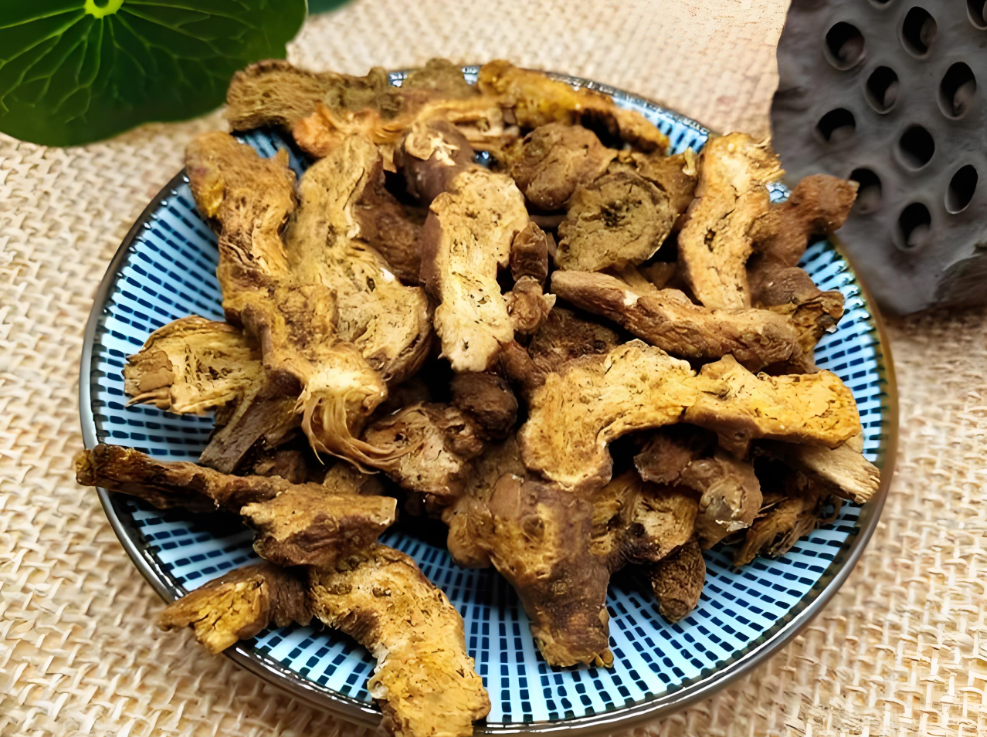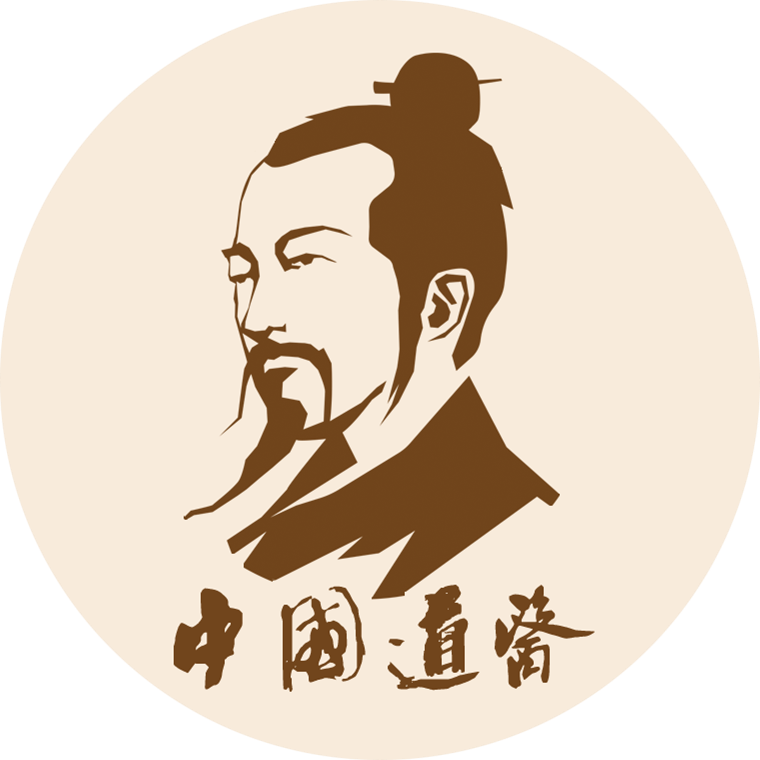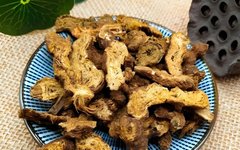
1. Aliases
Shan Jing, Chi Zhu, Ma Ji, Qing Zhu, Xian Zhu.
2. Plant Morphology
The rhizome is horizontal or obliquely ascending, with adventitious roots. The stem is erect, reaching up to 100 cm, solitary or clustered in small numbers, with the basal leaves falling during flowering; the middle and lower stem leaves are nearly stalkless, round, obovate, oblique ovate, ovate, or elliptical, while the upper stem leaves are undivided, oblong-ovate, oblong-ovate, or long-ovate. All leaves are thick and papery, green on both sides, hairless, with needle-like margins or triangular serrations. The head-like flower clusters are solitary at the top of the stem, with a bell-shaped involucre, and the bracts are needle-like and deeply divided. The small flowers are white, and the achenes are obovate, covered with dense, straight, white hairs. The pappus is brown or dirty white, flowering and fruiting from June to October.
3. Distribution
Found in Heilongjiang, Liaoning, Jilin, Inner Mongolia, Hebei, Shanxi, Gansu, Shaanxi, Henan, Jiangsu, Zhejiang, Jiangxi, Anhui, Sichuan, Hunan, Hubei, and other regions.
4. Harvesting and Processing
Wild Atractylodes can be harvested in spring, summer, and autumn, with the best quality obtained in August; cultivated Atractylodes should be harvested after two years of growth. Wild Atractylodes is mostly harvested in autumn, while Northern Atractylodes can be harvested in spring and autumn, with the best quality obtained when harvested before the seedlings emerge in early spring.
After harvesting, the above-ground parts are removed, and the rhizomes are shaken to remove soil. They are then dried and the fibrous roots are removed, or dried until 90% dry, then lightly scorched to remove the hairs. For Northern Atractylodes, the stems and leaves are removed, and they are dried to 40-50% dry, then placed in a basket, shaken to remove the fibrous roots, resulting in a dark brown color. They are then dried to 60-70% dry and shaken again to remove all old skin, and finally dried completely until the surface is yellow-brown.
5. Medicinal Properties
Irregularly bead-like or nodular cylindrical, slightly curved, occasionally branched, 3-10 cm long, 1-2 cm in diameter. The surface is gray-brown, with wrinkles, transverse grooves, and residual fibrous roots, with the apex showing stem scars or remnants of the stem base. The texture is solid, with a yellow-white or gray-white cross-section, scattered with numerous orange-yellow or brown-red oil chambers, which can produce white needle-like crystals upon exposure. The aroma is distinctive, with a slightly sweet, spicy, and bitter taste. Northern Atractylodes is lumpy or nodular cylindrical, 4-9 cm long, 1-4 cm in diameter. The surface is black-brown, and the inner skin is yellow-brown when removed. The texture is relatively loose, with a cross-section scattered with yellow-brown oil chambers. The aroma is milder, with a spicy and bitter taste.
6. Properties and Channels
Spicy, bitter, and warm, entering the Spleen, Stomach, and Liver meridians.
7. Effects and Functions
Dries dampness and strengthens the Spleen: Cang Zhu has a strong dampness-eliminating effect and can also strengthen the Spleen and tonify Qi. It is effective for symptoms caused by dampness obstructing the middle Jiao, such as abdominal distension, nausea, reduced appetite, vomiting, diarrhea, fatigue, and a white greasy tongue coating. It can treat both the symptoms and the root cause, with good effects when used alone, such as in Ping Wei San (Calm the Stomach Powder) and Wei Ling Tang (Stomach Strengthening Decoction).
Expels wind and disperses cold: Cang Zhu can eliminate internal dampness and expel external dampness, commonly used to treat conditions with heavy dampness, such as bi syndrome, damp sores, eczema, and dampness-related leukorrhea. Cang Zhu has a certain sweating effect and is particularly suitable for wind-cold exterior conditions with dampness, and for those with heavy head and body pain.
Improves vision: Cang Zhu contains a large amount of vitamin A, which can be effective for patients with blurred vision or night blindness.
8. Clinical Applications
Used for dampness obstructing the Spleen and Stomach, abdominal distension, cold damp leukorrhea, damp-heat diseases, and conditions such as swollen knees and feet, weakness, and fatigue.
Used for wind-damp pain, joint pain in limbs.
Used for wind-cold exterior conditions.
Used for night blindness and blurred vision.
9. Pharmacological Research
Regulates gastrointestinal motility; its decoction can significantly reduce the tension of the isolated small intestine in rabbits and can counteract acetylcholine-induced spasms in gastric and intestinal smooth muscles. It has a mild excitatory effect on normal rat gastric smooth muscle. The main active components are Atractylon and β-eucalyptol.
Its decoction improves diarrhea, body weight, and hypermotility in a Spleen deficiency model in rats.
Anti-ulcer and glandular inhibition: This herb has a strong inhibitory effect on pyloric ligation ulcers and stress-induced ulcers; it significantly inhibits gastric juice volume, total acidity, and total digestive capacity in animals.
The inhibition of gastric juice secretion is related to its suppression of gastrin release and the reduction of steroid hormone stimulation on gastric acid secretion. Its anti-ulcer effect is also related to enhancing gastric mucosal defense factors.
The volatile oil of Cang Zhu can also inhibit the secretion of salivary and intestinal glands, reducing saliva and intestinal fluid secretion.
Hepatoprotective: Its extracts and components such as Atractylon, β-eucalyptol, and Atractylodes ketone have significant preventive effects against liver cell damage induced by CCl4 and D-galactosamine.
10. Chemical Components
Atractylon, Atractylodes alcohol, β-eucalyptol, etc. Northern Atractylodes rhizomes contain 1.5% volatile oil, with the main components being Atractylon, Atractylodes ketone, Atractylodes alcohol, and eucalyptol. Eastern Atractylodes rhizomes also contain 1.5% volatile oil, with the main components being Atractylon, Atractylodes alcohol, β-eucalyptol, Atractylodes furan, and Atractylodes ketone.
11. Contraindications
Should not be used by those with Yin deficiency and internal heat, or those with Qi deficiency and excessive sweating.
12. Compatible Formulas
① For treating summer heat diarrhea and food injury causing chest fullness: Shen Qu (fermented wheat, fried) and Cang Zhu (soaked in rice wash overnight and dried) in equal parts, ground into powder. Form into pills the size of a phoenix seed. Take thirty pills with rice drink at any time. (From “Tai Ping Hui Min He Ji Ju Fang” Qu Zhu Wan)
② For treating diarrhea: Cang Zhu 100g and Xiao Jiao (small pepper) 50g (remove seeds and fry). Grind into a fine powder, mix with vinegar to form pills the size of a phoenix seed. Take twenty or thirty pills before meals with warm water. (From “Su Wen Bing Ji Bao Ming Ji” Jiao Zhu Wan)
③ For treating diarrhea: Cang Zhu 100g and Xiao Jiao 50g (remove seeds and fry). Grind into a fine powder, mix with vinegar to form pills the size of a phoenix seed. Take twenty or thirty pills before meals with warm water. (From “Su Wen Bing Ji Bao Ming Ji” Jiao Zhu Wan)
④ For treating seasonal epidemic headaches, neck stiffness, fever, chills, body aches, and colds: Cang Zhu (soaked in rice wash overnight and dried) 250g, Gao Ben (remove soil), Xiang Bai Zhi, Xi Xin (remove leaves and soil), Qiang Huo (remove reed), Chuan Xiong, and Gan Cao (honey-fried) each 50g. Grind into a fine powder. Take 15g with one cup of water, three slices of ginger, and three inches of scallion, decoct until reduced to seven-tenths, and take warm at any time. If feeling cold and congested, use scallion tea to adjust. (From “Tai Ping Hui Min He Ji Ju Fang” Shen Zhu San)
⑤ For treating Spleen and Stomach disharmony, loss of appetite, fullness and stabbing pain in the chest and abdomen, bitter taste with no flavor, nausea, and frequent diarrhea: Cang Zhu (remove coarse skin, soaked in rice wash for two days) 2500g, Hou Po (remove coarse skin, processed with ginger juice, fried until fragrant), Chen Pi (remove white) each 1600g, and Gan Cao (fried) 1500g. Grind into a fine powder. Take 10g with one cup of water, add two slices of ginger and two jujubes, decoct until reduced to seven-tenths, remove ginger and jujubes, and take warm before meals; adding a pinch of salt to boiling soup is also acceptable. (From “Ju Fang” Ping Wei San)






Daoist Medical Video Account
⊙ The content of this article is for clinical reference only; non-TCM professionals should not attempt to use these herbs.
⊙ Some images and texts are sourced from the internet; please contact us for removal if there is any infringement.
⊙ For Daoist medical consultations, add WeChat ID: daojiaoh
⊙ For submissions and collaborations: [email protected] (original submissions are welcome)
Selected Articles
❶ People who frequently wake up between 3-5 AM are at risk of sudden death; particularly beware of these three diseases, and how to adjust?
❷ Anxiety and insomnia? Zhang Zhongjing’s favorite herb for nourishing Yin is lily, but many people do not consume it correctly!
❸ Daoist alchemical practice: What are dynamic and static practices, and what is their relationship?
❹ When the meridians are open, the body will be healthy! Massage these acupoints to ensure smooth meridians and abundant Qi and blood!
❺ This formula with only three herbs can tonify both Yin and Yang, harmonize the Liver and Spleen, and alleviate pain!
❻ Daily learning of Chinese herbs: Shan Nai!
❼ Qi and blood are the foundation of life; five methods to help you enrich and smooth Qi and blood!
❽ An ancient famous formula that enhances immunity, nurturing the righteous Qi internally while expelling evil Qi externally!
❾ Daoist Tianxin school’s alchemical methods and introductory practices, quick success, easy to understand!

 Scan to Follow Daoist Medicine
Scan to Follow Daoist Medicine
Here, there are no chicken soup, folk prescriptions, rumors, or advertisements, only reliable Daoist health and wellness knowledge.


